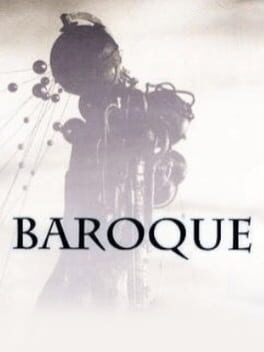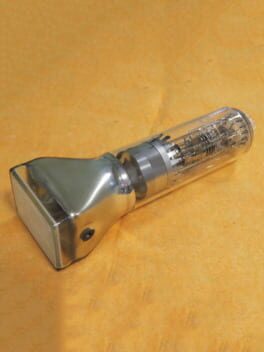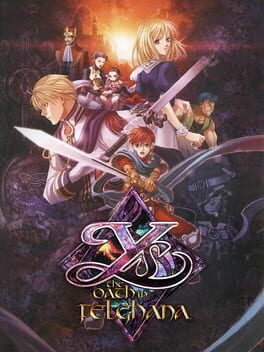kisaragirat
8 reviews liked by kisaragirat
Baroque
1998
The cathode-ray tube (CRT) is a vacuum tube that contains one or more electron guns and a phosphorescent screen, and is used to display images.[1] It modulates, accelerates, and deflects electron beam(s) onto the screen to create the images. The images may represent electrical waveforms (oscilloscope), pictures (television, computer monitor), radar targets, or other phenomena. CRTs have also been used as memory devices, in which case the visible light emitted from the fluorescent material (if any) is not intended to have significant meaning to a visual observer (though the visible pattern on the tube face may cryptically represent the stored data).
In television sets and computer monitors, the entire front area of the tube is scanned repetitively and systematically in a fixed pattern called a raster. In color devices, an image is produced by controlling the intensity of each of the three electron beams, one for each additive primary color (red, green, and blue) with a video signal as a reference.[2] In all modern CRT monitors and televisions, the beams are bent by magnetic deflection, a varying magnetic field generated by coils and driven by electronic circuits around the neck of the tube, although electrostatic deflection is commonly used in oscilloscopes, a type of electronic test instrument.[2]
A 14-inch cathode-ray tube showing its deflection coils and electron guns
Typical 1950s United States monochrome television set
A CRT television filmed in slow motion. The line of light is being drawn from left to right in a raster pattern
A flat CRT assembly inside a 1984 Sinclair FTV1 pocket TV
Electron gun
A CRT is constructed from a glass envelope which is large, deep (i.e., long from front screen face to rear end), fairly heavy, and relatively fragile. The interior of a CRT is evacuated to approximately 0.01 pascals (9.9×10−8 atm)[3] to 133 nanopascals (1.31×10−12 atm),[4] evacuation being necessary to facilitate the free flight of electrons from the gun(s) to the tube's face. The fact that it is evacuated makes handling an intact CRT potentially dangerous due to the risk of breaking the tube and causing a violent implosion that can hurl shards of glass at great velocity. As a matter of safety, the face is typically made of thick lead glass so as to be highly shatter-resistant and to block most X-ray emissions, particularly if the CRT is used in a consumer product.
Since the late 2000s, CRTs have been largely superseded by newer "flat panel" display technologies such as LCD, plasma display, and OLED displays, which have lower manufacturing costs and power consumption, as well as significantly less weight and bulk. Flat-panel displays can also be made in very large sizes; whereas 38 to 40 in (97 to 102 cm) was about the largest size of a CRT television, flat panels are available in 85 in (220 cm) and even larger sizes.
History
Braun's original cold-cathode CRT, 1897
Cathode rays were discovered by Julius Plücker and Johann Wilhelm Hittorf.[5] Hittorf observed that some unknown rays were emitted from the cathode (negative electrode) which could cast shadows on the glowing wall of the tube, indicating the rays were traveling in straight lines. In 1890, Arthur Schuster demonstrated cathode rays could be deflected by electric fields, and William Crookes showed they could be deflected by magnetic fields. In 1897, J. J. Thomson succeeded in measuring the charge-mass-ratio of cathode rays, showing that they consisted of negatively charged particles smaller than atoms, the first "subatomic particles", which had already been named electrons by Irish physicist, George Johnstone Stoney in 1891. The earliest version of the CRT was known as the "Braun tube", invented by the German physicist Ferdinand Braun in 1897.[6] It was a cold-cathode diode, a modification of the Crookes tube with a phosphor-coated screen.
The first cathode-ray tube to use a hot cathode was developed by John Bertrand Johnson (who gave his name to the term Johnson noise) and Harry Weiner Weinhart of Western Electric, and became a commercial product in 1922.[citation needed]
In 1926, Kenjiro Takayanagi demonstrated a CRT television that received images with a 40-line resolution.[7] By 1927, he improved the resolution to 100 lines, which was unrivaled until 1931.[8] By 1928, he was the first to transmit human faces in half-tones on a CRT display.[9] By 1935, he had invented an early all-electronic CRT television.[10]
It was named in 1929 by inventor Vladimir K. Zworykin,[11] who was influenced by Takayanagi's earlier work.[9] RCA was granted a trademark for the term (for its cathode-ray tube) in 1932; it voluntarily released the term to the public domain in 1950.[12]
The first commercially made electronic television sets with cathode-ray tubes were manufactured by Telefunken in Germany in 1934.[13][14]
Flat panel displays dropped in price and started significantly displacing cathode-ray tubes in the 2000s, with LCD screens exceeding CRTs in 2008.[15] The last known manufacturer of (in this case, recycled) CRTs, Videocon, ceased in 2015.[16][17]
Oscilloscope CRTs
An oscilloscope showing a Lissajous curve
In oscilloscope CRTs, electrostatic deflection is used, rather than the magnetic deflection commonly used with television and other large CRTs. The beam is deflected horizontally by applying an electric field between a pair of plates to its left and right, and vertically by applying an electric field to plates above and below. Televisions use magnetic rather than electrostatic deflection because the deflection plates obstruct the beam when the deflection angle is as large as is required for tubes that are relatively short for their size.
Phosphor persistence
Various phosphors are available depending upon the needs of the measurement or display application. The brightness, color, and persistence of the illumination depends upon the type of phosphor used on the CRT screen. Phosphors are available with persistences ranging from less than one microsecond to several seconds.[18] For visual observation of brief transient events, a long persistence phosphor may be desirable. For events which are fast and repetitive, or high frequency, a short-persistence phosphor is generally preferable.[19]
Microchannel plate
When displaying fast one-shot events, the electron beam must deflect very quickly, with few electrons impinging on the screen, leading to a faint or invisible image on the display. Oscilloscope CRTs designed for very fast signals can give a brighter display by passing the electron beam through a micro-channel plate just before it reaches the screen. Through the phenomenon of secondary emission, this plate multiplies the number of electrons reaching the phosphor screen, giving a significant improvement in writing rate (brightness) and improved sensitivity and spot size as well.[20][21]
Graticules
Most oscilloscopes have a graticule as part of the visual display, to facilitate measurements. The graticule may be permanently marked inside the face of the CRT, or it may be a transparent external plate made of glass or acrylic plastic. An internal graticule eliminates parallax error, but cannot be changed to accommodate different types of measurements.[22] Oscilloscopes commonly provide a means for the graticule to be illuminated from the side, which improves its visibility.[23]
Image storage tubes
The Tektronix Type 564: first mass-produced analog phosphor storage oscilloscope
These are found in analog phosphor storage oscilloscopes. These are distinct from digital storage oscilloscopes which rely on solid state digital memory to store the image.
Where a single brief event is monitored by an oscilloscope, such an event will be displayed by a conventional tube only while it actually occurs. The use of a long persistence phosphor may allow the image to be observed after the event, but only for a few seconds at best. This limitation can be overcome by the use of a direct view storage cathode-ray tube (storage tube). A storage tube will continue to display the event after it has occurred until such time as it is erased. A storage tube is similar to a conventional tube except that it is equipped with a metal grid coated with a dielectric layer located immediately behind the phosphor screen. An externally applied voltage to the mesh initially ensures that the whole mesh is at a constant potential. This mesh is constantly exposed to a low velocity electron beam from a 'flood gun' which operates independently of the main gun. This flood gun is not deflected like the main gun but constantly 'illuminates' the whole of the storage mesh. The initial charge on the storage mesh is such as to repel the electrons from the flood gun which are prevented from striking the phosphor screen.
When the main electron gun writes an image to the screen, the energy in the main beam is sufficient to create a 'potential relief' on the storage mesh. The areas where this relief is created no longer repel the electrons from the flood gun which now pass through the mesh and illuminate the phosphor screen. Consequently, the image that was briefly traced out by the main gun continues to be displayed after it has occurred. The image can be 'erased' by resupplying the external voltage to the mesh restoring its constant potential. The time for which the image can be displayed was limited because, in practice, the flood gun slowly neutralises the charge on the storage mesh. One way of allowing the image to be retained for longer is temporarily to turn off the flood gun. It is then possible for the image to be retained for several days. The majority of storage tubes allow for a lower voltage to be applied to the storage mesh which slowly restores the initial charge state. By varying this voltage a variable persistence is obtained. Turning off the flood gun and the voltage supply to the storage mesh allows such a tube to operate as a conventional oscilloscope tube.[24]
In television sets and computer monitors, the entire front area of the tube is scanned repetitively and systematically in a fixed pattern called a raster. In color devices, an image is produced by controlling the intensity of each of the three electron beams, one for each additive primary color (red, green, and blue) with a video signal as a reference.[2] In all modern CRT monitors and televisions, the beams are bent by magnetic deflection, a varying magnetic field generated by coils and driven by electronic circuits around the neck of the tube, although electrostatic deflection is commonly used in oscilloscopes, a type of electronic test instrument.[2]
A 14-inch cathode-ray tube showing its deflection coils and electron guns
Typical 1950s United States monochrome television set
A CRT television filmed in slow motion. The line of light is being drawn from left to right in a raster pattern
A flat CRT assembly inside a 1984 Sinclair FTV1 pocket TV
Electron gun
A CRT is constructed from a glass envelope which is large, deep (i.e., long from front screen face to rear end), fairly heavy, and relatively fragile. The interior of a CRT is evacuated to approximately 0.01 pascals (9.9×10−8 atm)[3] to 133 nanopascals (1.31×10−12 atm),[4] evacuation being necessary to facilitate the free flight of electrons from the gun(s) to the tube's face. The fact that it is evacuated makes handling an intact CRT potentially dangerous due to the risk of breaking the tube and causing a violent implosion that can hurl shards of glass at great velocity. As a matter of safety, the face is typically made of thick lead glass so as to be highly shatter-resistant and to block most X-ray emissions, particularly if the CRT is used in a consumer product.
Since the late 2000s, CRTs have been largely superseded by newer "flat panel" display technologies such as LCD, plasma display, and OLED displays, which have lower manufacturing costs and power consumption, as well as significantly less weight and bulk. Flat-panel displays can also be made in very large sizes; whereas 38 to 40 in (97 to 102 cm) was about the largest size of a CRT television, flat panels are available in 85 in (220 cm) and even larger sizes.
History
Braun's original cold-cathode CRT, 1897
Cathode rays were discovered by Julius Plücker and Johann Wilhelm Hittorf.[5] Hittorf observed that some unknown rays were emitted from the cathode (negative electrode) which could cast shadows on the glowing wall of the tube, indicating the rays were traveling in straight lines. In 1890, Arthur Schuster demonstrated cathode rays could be deflected by electric fields, and William Crookes showed they could be deflected by magnetic fields. In 1897, J. J. Thomson succeeded in measuring the charge-mass-ratio of cathode rays, showing that they consisted of negatively charged particles smaller than atoms, the first "subatomic particles", which had already been named electrons by Irish physicist, George Johnstone Stoney in 1891. The earliest version of the CRT was known as the "Braun tube", invented by the German physicist Ferdinand Braun in 1897.[6] It was a cold-cathode diode, a modification of the Crookes tube with a phosphor-coated screen.
The first cathode-ray tube to use a hot cathode was developed by John Bertrand Johnson (who gave his name to the term Johnson noise) and Harry Weiner Weinhart of Western Electric, and became a commercial product in 1922.[citation needed]
In 1926, Kenjiro Takayanagi demonstrated a CRT television that received images with a 40-line resolution.[7] By 1927, he improved the resolution to 100 lines, which was unrivaled until 1931.[8] By 1928, he was the first to transmit human faces in half-tones on a CRT display.[9] By 1935, he had invented an early all-electronic CRT television.[10]
It was named in 1929 by inventor Vladimir K. Zworykin,[11] who was influenced by Takayanagi's earlier work.[9] RCA was granted a trademark for the term (for its cathode-ray tube) in 1932; it voluntarily released the term to the public domain in 1950.[12]
The first commercially made electronic television sets with cathode-ray tubes were manufactured by Telefunken in Germany in 1934.[13][14]
Flat panel displays dropped in price and started significantly displacing cathode-ray tubes in the 2000s, with LCD screens exceeding CRTs in 2008.[15] The last known manufacturer of (in this case, recycled) CRTs, Videocon, ceased in 2015.[16][17]
Oscilloscope CRTs
An oscilloscope showing a Lissajous curve
In oscilloscope CRTs, electrostatic deflection is used, rather than the magnetic deflection commonly used with television and other large CRTs. The beam is deflected horizontally by applying an electric field between a pair of plates to its left and right, and vertically by applying an electric field to plates above and below. Televisions use magnetic rather than electrostatic deflection because the deflection plates obstruct the beam when the deflection angle is as large as is required for tubes that are relatively short for their size.
Phosphor persistence
Various phosphors are available depending upon the needs of the measurement or display application. The brightness, color, and persistence of the illumination depends upon the type of phosphor used on the CRT screen. Phosphors are available with persistences ranging from less than one microsecond to several seconds.[18] For visual observation of brief transient events, a long persistence phosphor may be desirable. For events which are fast and repetitive, or high frequency, a short-persistence phosphor is generally preferable.[19]
Microchannel plate
When displaying fast one-shot events, the electron beam must deflect very quickly, with few electrons impinging on the screen, leading to a faint or invisible image on the display. Oscilloscope CRTs designed for very fast signals can give a brighter display by passing the electron beam through a micro-channel plate just before it reaches the screen. Through the phenomenon of secondary emission, this plate multiplies the number of electrons reaching the phosphor screen, giving a significant improvement in writing rate (brightness) and improved sensitivity and spot size as well.[20][21]
Graticules
Most oscilloscopes have a graticule as part of the visual display, to facilitate measurements. The graticule may be permanently marked inside the face of the CRT, or it may be a transparent external plate made of glass or acrylic plastic. An internal graticule eliminates parallax error, but cannot be changed to accommodate different types of measurements.[22] Oscilloscopes commonly provide a means for the graticule to be illuminated from the side, which improves its visibility.[23]
Image storage tubes
The Tektronix Type 564: first mass-produced analog phosphor storage oscilloscope
These are found in analog phosphor storage oscilloscopes. These are distinct from digital storage oscilloscopes which rely on solid state digital memory to store the image.
Where a single brief event is monitored by an oscilloscope, such an event will be displayed by a conventional tube only while it actually occurs. The use of a long persistence phosphor may allow the image to be observed after the event, but only for a few seconds at best. This limitation can be overcome by the use of a direct view storage cathode-ray tube (storage tube). A storage tube will continue to display the event after it has occurred until such time as it is erased. A storage tube is similar to a conventional tube except that it is equipped with a metal grid coated with a dielectric layer located immediately behind the phosphor screen. An externally applied voltage to the mesh initially ensures that the whole mesh is at a constant potential. This mesh is constantly exposed to a low velocity electron beam from a 'flood gun' which operates independently of the main gun. This flood gun is not deflected like the main gun but constantly 'illuminates' the whole of the storage mesh. The initial charge on the storage mesh is such as to repel the electrons from the flood gun which are prevented from striking the phosphor screen.
When the main electron gun writes an image to the screen, the energy in the main beam is sufficient to create a 'potential relief' on the storage mesh. The areas where this relief is created no longer repel the electrons from the flood gun which now pass through the mesh and illuminate the phosphor screen. Consequently, the image that was briefly traced out by the main gun continues to be displayed after it has occurred. The image can be 'erased' by resupplying the external voltage to the mesh restoring its constant potential. The time for which the image can be displayed was limited because, in practice, the flood gun slowly neutralises the charge on the storage mesh. One way of allowing the image to be retained for longer is temporarily to turn off the flood gun. It is then possible for the image to be retained for several days. The majority of storage tubes allow for a lower voltage to be applied to the storage mesh which slowly restores the initial charge state. By varying this voltage a variable persistence is obtained. Turning off the flood gun and the voltage supply to the storage mesh allows such a tube to operate as a conventional oscilloscope tube.[24]







